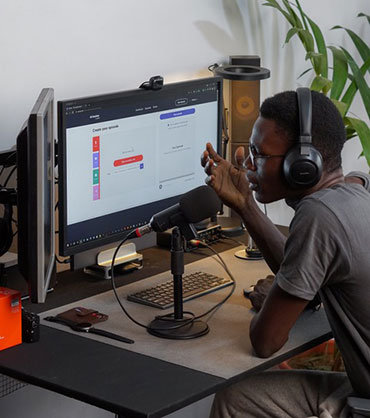Simultaneous Online and On-Site Translation

For over 25 years I’ve worked as a conference interpreter. And voice coaching was always something I took an interest in and paid attention to. Obviously, as important as accuracy and your word and linguistic choices in the booth is the voice you use to address the audience. Like actors and television hosts, interpreters must carry someone else’s story convincingly enough to achieve the intended impact. And this involves conveying the emotion behind the words. There’s no way you can achieve that if you speak in a monotone.
Additionally, it can be really tiring to sit down for a whole day and listen to presentations… much more so if you’re listening to a translation of the original speech, with a device pinned to your ear. It must be a pleasant experience, the speech must make sense and the voice must be “alive”. I thought I’d make it more pleasant for my listeners if I educated my voice. And so I did.
Interpreters and interpreting
Interpreting is the act of facilitating oral communication, either simultaneously or consecutively, between users of different languages. Not only oral communication, also sign-language communication, but for our purpose here we will stick to oral language interpreting only.
Interpreting is often referred to as translation, which may be confusing, since there is also written translation. So a more correct terminology would be simultaneous, or consecutive, translation. Likewise, interpreters and translators, two words that are often confused as well, refer to the professionals who do oral translation and those who do written translation.
An interpreter converts what is said in a source language into a speech with a comparable meaning in a target language either simultaneously, that is nearly in “real time”, or consecutively, when the speaker pauses every now and then for the interpreter to deliver his version in the target language.
A good interpreter should be able to convey not only semantic elements in the source language but also tone and register, intention and feeling of the message that the speaker is directing at his audience.
Interpreting requires intense concentration. Interpreters need to hear every word the speaker utters and immediately produce an accurate rendition in the target language. This is why professional interpreters invariably work in pairs or in teams of three, taking turns at the microphone every twenty or thirty minutes. Very long interpreting days, longer than 8h, require teams of three interpreters taking turns in the booth. This is a strategy used not only to spare the interpreters’ health but also to make sure that translation quality remains unchanged from beginning to end.
Simultaneous or conference translation
In the traditional setup, interpreters speak into a microphone inside a sound-proof booth, while listening to the speaker via earphones. The simultaneous interpreter then conveys the message to the target-language of the listeners via individual earphones.
For small meetings, factory tours or events outdoors (weddings, product launches, etc.) interpreters usually resort to portable translation equipment that works just like the traditional booth setup, though it doesn’t require one. Here, instead of sitting inside a booth, interpreters walk along the premises with the participants while simultaneously translating the speaker’s talk.
The major difficulty in any case is that the interpreters must do their best within the time set by the pace of the foreign speaker to convey the message as clearly and accurately as possible. The great advantage is that this format saves time, since it happens in nearly real time, and the interpreters don’t disturb the natural flow of the speaker.
Some simultaneous interpreters can also go into consecutive mode, but not all of them do, since it’s a completely different technique that more often than not involves fast note-taking. In the booth, simultaneous interpreters are given but one chance of getting it right. As Franz Pöchhacker puts it, you have the opportunity to produce “a first and final rendition in another language … on the basis of a one-time presentation of an utterance in the source language”.
In simultaneous translation, communication happens seamlessly in both directions. Usually interpreters are present on-site, that is, they are in the same venue as the speakers and therefore they can not only listen to but also see them. This is extremely helpful, particularly if the speakers start pointing at elements on a screen. The interpreters must then attempt to the best of their ability to cut down their usual recul/décalage (lag between the source utterance and translation, necessary sometimes for better sentence structuring) so that the audience hears the description/explanation at the exact moment that the speaker is pointing at that item.
Very often interpreters come across new challenges, such as jokes, which, to make sense, usually require deep knowledge of the speakers’ native culture. Other times, they are expected to translate puns that lose all meaning in translation. It is in these moments that interpreters need to fall back on their knowledge of the language and flexibility to deliver the same impact the speaker intended.
Consecutive translation
In consecutive translation, the speaker is required to pause regularly to enable the interpreter to translate what he has just said. Usually, they each speak into a microphone to the audience, so there is no need for participants to use headsets to listen to the translation. The booth is not necessary either. The great disadvantage is that in consecutive interpreting the time of speech doubles and those in the audience who master both languages get bored to death, as they are forced to listen to the same message twice.
Whispering (or chouchotage in French)
Whispered translation (chouchotage, in French) is used when there is no possibility of using a portable translation equipment, which enables the interpreter to go into simultaneous mode. In whispering, the interpreter simply speaks very softly using voiced speech. This requires proximity to the listeners and can feel rather intrusive depending on their cultural background. The disadvantage is that in whispering the maximum number of listeners is two.
Liaison or Escort Interpreting
In escort (liaison in French) interpreting, an interpreter accompanies executives, officials or a delegation on a tour, a roadshow, a visit, or to a meeting or interview. An interpreter in this position can either choose to carry along the portable translation equipment or go into whispering mode, the number of listeners allowing.
What a good interpreter needs to do a good job
To become an interpreter in Brazil, or anywhere else, one needs a number of attributes but among the most important are:
• Total mastery of the source and target languages
• A pleasant, educated voice
• Full control of the nerves under stress
• Insatiable curiosity
• Love for studying
• Patience
• Discipline
• Highly advance social skills
• A sharp mind
• Love for challenges
• To be a good team player (indispensable in the booth)
• Commitment to quality and high standards
Quality of translation
The quality of the translation that listeners will hear depends primarily on three major factors: the presence of seasoned, qualified interpreters in the both, speakers who understand they need to enunciate their words for the benefit of the audience (including those participants who will not use translation) top quality translation equipment and qualified technicians.
Sound is the key raw material with which interpreters work. It must be clear of humming, statics or any other interference. It should be well equalized, a perfect balance between bass and treble. Interpreters must be able to understand each and every word, no matter the speed or pitch the speaker adopts.
Poor sound quality can ruin a conference. It makes it impossible for interpreters to do a good job in translation. Try asking the best pastry chef in the world to bake you some bread but instead of flour, hand him a bag of sand. It is mission impossible, he will say.
Interpreting in São Paulo, Brazil
The interpreting community is reasonably small in Brazil but a variety of language combinations are available, particularly in São Paulo, Rio and Brasília. The most common language combinations are English / Portuguese, English / Spanish, Spanish / Portuguese and French / Portuguese. But rare language interpreters that do for instance Arabic into French or Portuguese, or Korean into English or Portuguese can also be found, though in small numbers.
The most important interpreters association in Brazil is APIC (www.apic.org.br), the Brazilian Conference Interpreters’ Association, stationed in Sao Paulo. To qualify as a fully-fledged member, interpreters must provide documentary evidence of their experience in the booth. In addition to working as a quality seal, APIC membership helps protect interpreters’ working conditions and basic requirements. APIC’s rules follow the overarching guidlines of the international organization AIIC (Association Internationale des Interprètes de Conférence ), headquartered in Geneva, Switzerland.
Check out my Master of Ceremonies page





